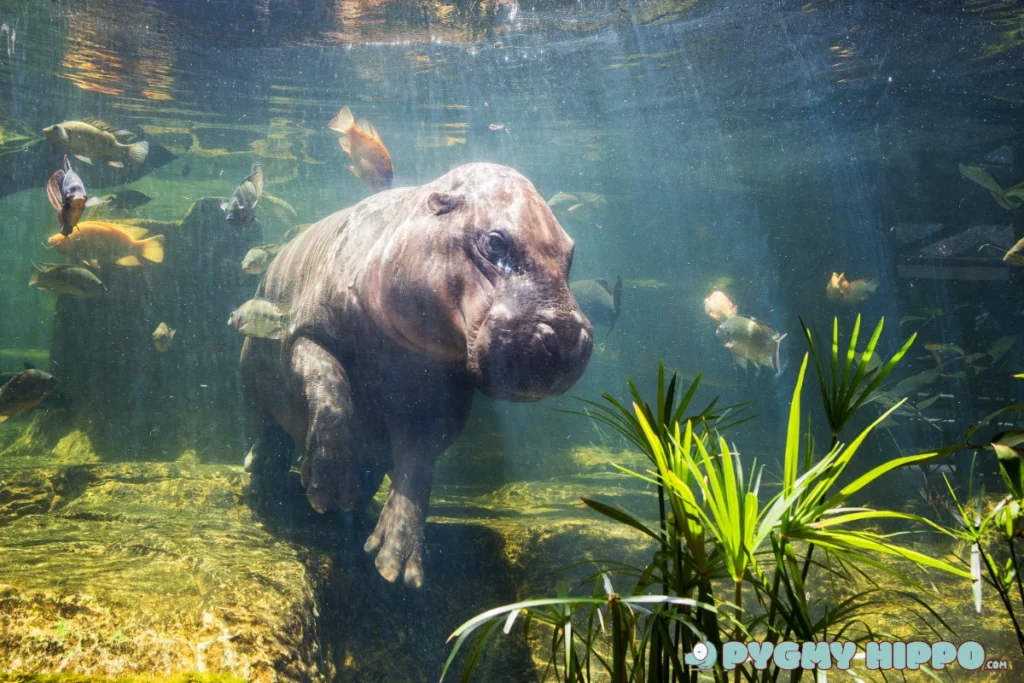The GreaPygmy Hippo Name Debate
The pygmy hippo name debate adds to the already considerable mystique surrounding this secretive species. The taxonomic classification of the Pygmy Hippopotamus, alternating between Choeropsis liberiensis and Hexaprotodon liberiensis, is a subject of ongoing debate among zoologists and taxonomists, illustrating the complexities inherent in the scientific categorization of species. This debate primarily stems from morphological and genetic analyses that suggest differing degrees of relatedness between the Pygmy Hippo and its larger counterpart, the common hippopotamus (Hippopotamus amphibius), as well as other members of the Hippopotamidae family.

The genus Choeropsis, meaning “resembling a pig,” was initially assigned due to the Pygmy Hippo’s smaller size and certain pig-like features. However, further studies highlighted distinct characteristics that warranted a separate classification, leading to the introduction of the genus Hexaprotodon, which means “six front teeth,” referencing the specific dental arrangement found in these animals, distinct from other hippopotamids.
This taxonomic ambiguity is further complicated by fossil records and genetic data. Fossil evidence suggests that Hexaprotodon species were once more widespread across Africa and Asia, indicating a broader genus that encompassed several extinct species with similar dental structures, which might include the ancestor of the modern Pygmy Hippo. Genetic analyses, however, have shown a closer evolutionary relationship between the Pygmy Hippo and the common hippopotamus, suggesting they diverged from a common ancestor relatively recently in geological terms.
This evidence supports the argument for a closer grouping, potentially under the same genus. The debate, therefore, centers on whether the morphological differences (particularly in dentition and size) or the genetic similarities should hold more weight in the taxonomic classification. This dilemma exemplifies the dynamic nature of taxonomy, which evolves with our understanding of species’ relationships, influenced by new scientific evidence and methodologies. As such, the debate over the taxonomic name of the Pygmy Hippo underscores the broader challenges in classifying life’s diversity, reflecting ongoing efforts to refine our understanding of biological relationships in the light of advancing research.
The Nigerian Pygmy Hippo Subspecies Heslopi
Of the two recognized subspecies of the endangered pygmy hippopotamus, the C. liberiensis heslopi variant faces the bleakest outlook. Historically, this isolated population inhabited Nigeria’s riverine forests particularly within the Niger Delta region up until the late 20th century when extensive habitat loss largely eradicated wild populations.
First described in the early 1900s from specimens obtained along the Senegal River, taxonomists eventually reclassified these specific hippos as the heslopi subspecies given certain slight morphological differences. On average, heslopi hippos stand about 2 inches shorter in height compared to the more westerly liberiensis subspecies populations. Researchers also noted heslopi’s cranial dimensions differ somewhat in width and angularity.
However, zoologists still do not fully understand the extent of divergence between liberiensis and heslopi as distinct isolated populations because so few specimens exist in captivity, let alone the wild. Due to the extreme rarity of Nigerian pygmy hippos lately, very limited genetic or behavioral comparisons and observations proved possible to comprehensively contrast against liberiensis variations.
Several attempts between the 1960s-1990s sought to locate any remnant heslopi individuals in Nigeria without success. Habitat encroachment through the densely populated Niger River Delta seemingly eradicated all native pygmy hippos from the region. For now taxonomists still categorize C. l. heslopi as a valid subspecies. But without evidence of living populations, eventually scientists may be forced to reclassify it as extinct if none emerge. Some experts hold out hope undisclosed pockets endure deep within remaining rainforest patches, or perhaps evidence exists within captive zoo hippos of ambiguous origin that may yet reveal heslopi genes. Still, the unknown fate of the mysterious Nigerian pygmy hippo serves as a sobering reminder of how rapidly human activities can erase unique wildlife from existence when conservation measures falter.